Themed collection 2022 Journal of Materials Chemistry Lectureship runners-up: Jessica Wade and Luisa Whittaker-Brooks

Pathways to increase the dissymmetry in the interaction of chiral light and chiral molecules
This perspective explores the dissymmetric interaction between circularly polarised (CP) light and chiral molecules. Such interactions are central to many applications from next generation displays to asymmetric photochemical synthesis.

Chem. Sci., 2021,12, 8589-8602
https://doi.org/10.1039/D1SC02335G
Concepts and principles of self-n-doping in perylene diimide chromophores for applications in biochemistry, energy harvesting, energy storage, and catalysis
Self-doping is an essential method of increasing carrier concentrations in organic electronics that eliminates the need to tailor host—dopant miscibility, a necessary step when employing molecular dopants.
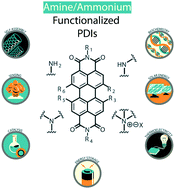
Mater. Horiz., 2022,9, 2026-2052
https://doi.org/10.1039/D2MH00279E
Best practices in the measurement of circularly polarised photodetectors
Here we provide a framework of standardised apparatus and tests which enable rigorous characterisation of the performance of photodetectors sensitive to circular polarisation, enabling meaningful comparisons between devices reported in literature.

J. Mater. Chem. C, 2022,10, 10452-10463
https://doi.org/10.1039/D2TC01224C
Resolving buried optoelectronic features in metal halide perovskites via modulation spectroscopy studies
As research on both bulk and low dimensional metal halide perovskites (MHPs) continues to grow, the tools necessary to gain insights into their exotic and highly convoluted optoelectronic features must also expand.
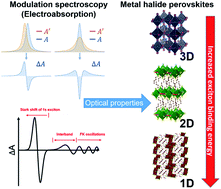
J. Mater. Chem. A, 2021,9, 23746-23764
https://doi.org/10.1039/D1TA06484C
On the factors influencing the chiroptical response of conjugated polymer thin films
We study the influence of the physical and chemical structure on the chiroptical response of fluorene-based polymeric systems and reveal the significance of electric-magnetic coupling, at both short and intermediate length scales on the magnitude of the dissymmetry.
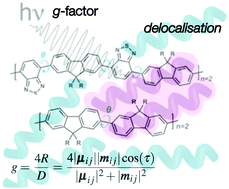
Chem. Commun., 2021,57, 9914-9917
https://doi.org/10.1039/D1CC02918E
Enhanced sensing in mixed porous–solid photonic stacks
A mix-and-match sol–gel deposition method allows fabrication of one-dimensional photonic bandgap materials with strategically placed porous layers.

J. Mater. Chem. C, 2016,4, 668-672
https://doi.org/10.1039/C5TC03581C
Polaron stability in semiconducting polymer neat films
We describe a spectroelectrochemical approach to accelerated electrochemical stability studies of conjugated polymers under oxidative stress. The polaron stabilities of alternating copolymers based on (i) thiophene and thiazole, namely PTTz, and (ii) bithiophene and thiazole, namely PTTTz, are compared in neat films with that of P3HT. P3HT is found to be the most stable whilst PTTz is found to be the least stable.
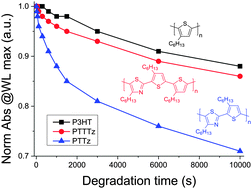
Chem. Commun., 2014,50, 14425-14428
https://doi.org/10.1039/C4CC06193D
Face-on stacking and enhanced out-of-plane hole mobility in graphene-templated copper phthalocyanine
The out-of-plane hole mobility in copper phthalocyanine is enhanced by face-on molecular stacking induced by graphene-templated growth.
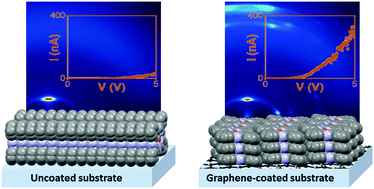
Chem. Commun., 2014,50, 5319-5321
https://doi.org/10.1039/C3CC47516F
Lithium deposition mechanism on Si and Cu substrates in the carbonate electrolyte
The nucleation and growth mechanisms of Li deposits on Si and Cu substrates in commercial carbonate electrolyte are detailly presented, which indicates how various design parameters regulate Li deposit morphology and affect battery performance.
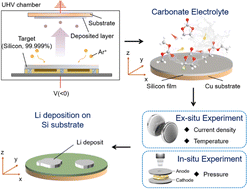
Energy Environ. Sci., 2022,15, 5284-5299
https://doi.org/10.1039/D2EE01833K
Enhancing hole carrier injection via low electrochemical doping on circularly polarized polymer light-emitting diodes
The noble electrochemical doping agent enables stable electrochemical doping of achiral π-CP in π-CP:aza[6]H blends, which allows better charge injection and balance for efficient circularly polarized optoelectronic devices.
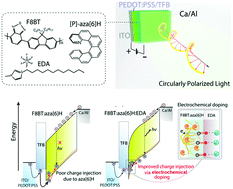
J. Mater. Chem. C, 2022,10, 9512-9520
https://doi.org/10.1039/D2TC01010K
Engineering the sign of circularly polarized emission in achiral polymer – chiral small molecule blends as a function of blend ratio
We demonstrate CP-OLEDs with an impressive electroluminescence dissymmetry factor (gEL) > 0.3. The handedness of circularly polarized PL/EL can be inverted by varying the active layer thickness and chiral additive loading ratio.
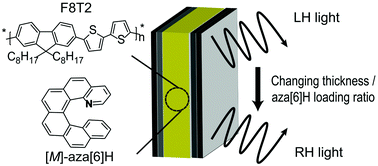
J. Mater. Chem. C, 2022,10, 5168-5172
https://doi.org/10.1039/D1TC05403A
Charge transfer states and carrier generation in 1D organolead iodide semiconductors
Naphthalene diimide based diammonium cations can be utilized to produce 1D organic/inorganic metal halide semiconductors with internal charge separation via charge transfer states that lie energetically below the metal-halide excitonic absorption.
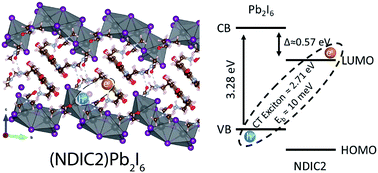
J. Mater. Chem. A, 2021,9, 14977-14990
https://doi.org/10.1039/D1TA03325E
Steric hindrance dependence on the spin and morphology properties of highly oriented self-doped organic small molecule thin films
We provide fundamental design principles on the effect of dopant structure (steric hindrance) on the doping efficiency in highly oriented self-doped organic semiconducting thin films.

Mater. Adv., 2021,2, 356-365
https://doi.org/10.1039/D0MA00822B
Voltage bias stress effects in metal halide perovskites are strongly dependent on morphology and ion migration pathways
We determined how morphology, electronic and interfacial interactions affect perovskite PVs under voltage bias stress. Our findings provide insights into the discrepancies in the solar cell efficiencies observed across many different research groups.
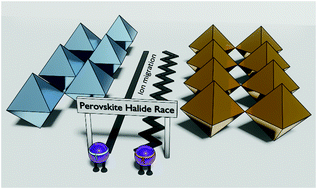
J. Mater. Chem. A, 2020,8, 25109-25119
https://doi.org/10.1039/D0TA10371C
Quantifying multiple crystallite orientations and crystal heterogeneities in complex thin film materials
Using the mosaicity factor and GIWAXS diffraction patterns to quantify crystallite heterogeneities and orientation in thin film materials.
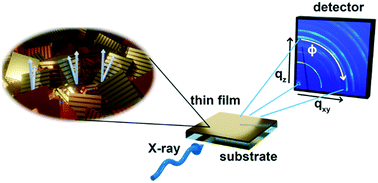
CrystEngComm, 2019,21, 5707-5720
https://doi.org/10.1039/C9CE01010F
Vertically oriented TiS2−x nanobelt arrays as binder- and carbon-free intercalation electrodes for Li- and Na-based energy storage devices
Vertically-oriented TiS2 nanobelt arrays allow for the fabrication of carbon- and binder- free electrodes with high ion diffusion lengths.

J. Mater. Chem. A, 2018,6, 21949-21960
https://doi.org/10.1039/C8TA05645E
Systematic control of heteroatoms in donor–acceptor copolymers and its effects on molecular conformation and photovoltaic performance
Understanding the effects of heteroatom substitutions in donor–acceptor copolymers on their electronic structure, conformation, molecular packing, and optoelectronic device performance.

J. Mater. Chem. C, 2016,4, 7966-7978
https://doi.org/10.1039/C6TC01936F
Natures of optical absorption transitions and excitation energy dependent photostability of diketopyrrolopyrrole (DPP)-based photovoltaic copolymers
The photostability of diketopyrrolopyrrole (DPP)-based copolymers is examined by investigating the natures of the two dominant optical absorption transitions.
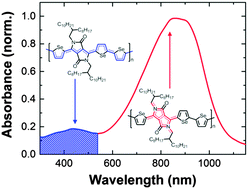
Energy Environ. Sci., 2015,8, 3222-3232
https://doi.org/10.1039/C5EE01974E
Bi2S3 nanowire networks as electron acceptor layers in solution-processed hybrid solar cells
We report the assembly of Bi2S3 into percolated networks.
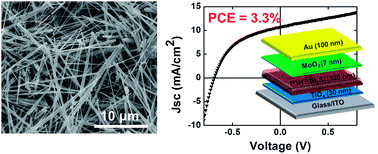
J. Mater. Chem. C, 2015,3, 2686-2692
https://doi.org/10.1039/C4TC02534B
Charge mobility anisotropy of functionalized pentacenes in organic field effect transistors fabricated by solution processing
Zone casting at controlled substrate displacement rates forms highly aligned crystalline domains of functionalized pentacenes, which allows us to investigate charge-transport anisotropy due to molecular packing and microstructure.
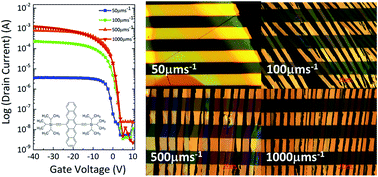
J. Mater. Chem. C, 2014,2, 10110-10115
https://doi.org/10.1039/C4TC01353K
Photochemical stability of high efficiency PTB7:PC70BM solar cell blends
In situ Raman spectroscopy can probe degradation-induced molecular changes within thin film organic solar cells, revealing that the polymer PTB7 degrades via a 2-step photo-oxidation process localized on the benzodithiophene unit.
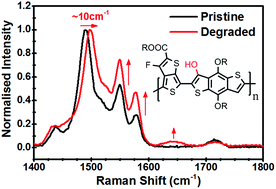
J. Mater. Chem. A, 2014,2, 20189-20195
https://doi.org/10.1039/C4TA05641H
Intermediate metallic phase in VO2 observed with scanning tunneling spectroscopy
An intermediate metallic phase of VO2 has been observed in differential tunnelling conductance spectra and images obtained during the MIT with STS.
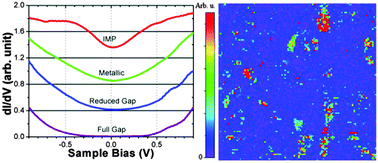
Phys. Chem. Chem. Phys., 2014,16, 14183-14188
https://doi.org/10.1039/C4CP01551G
About this collection
We are delighted to announce that Professor Sahika Inal has been selected as the winner of the Journal of Materials Chemistry Lectureship 2022. This year we are also pleased to celebrate two runners-up, Jessica Wade and Luisa Whittaker-Brooks!
Each year we have a large number of excellent researchers nominated for the lectureship award across Journal of Materials Chemistry A, B and C. To recognise the diversity of the three journals, overall community and candidates nominated each year, going forward we have decided to additionally recognise runners-up for the Journal of Materials Chemistry lectureship.
To celebrate, we have put together this collection of Jessica and Luisa’s publications in Royal Society of Chemistry journals. We hope you enjoy reading this collection of fantastic research from our Journal of Materials Chemistry lectureship runners-up! You can learn more about Jess and Luisa on our blog.